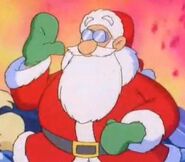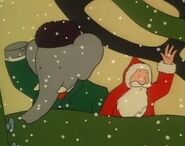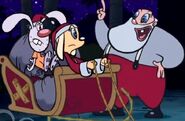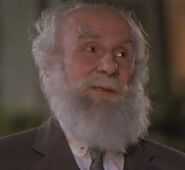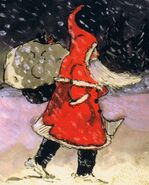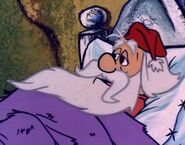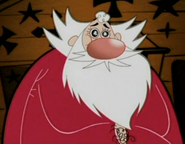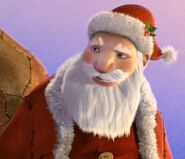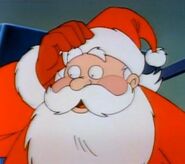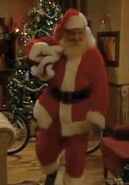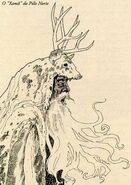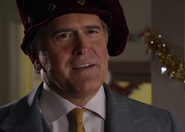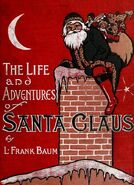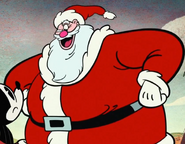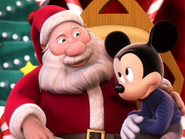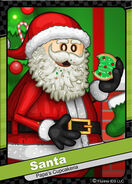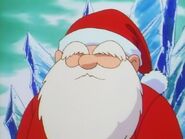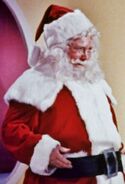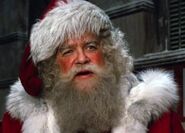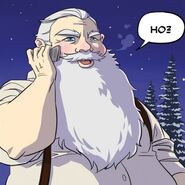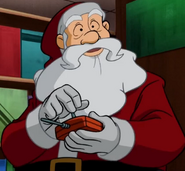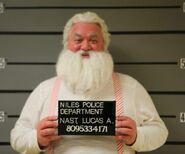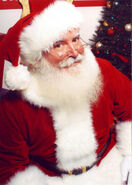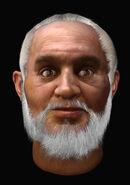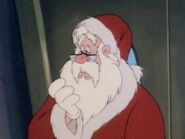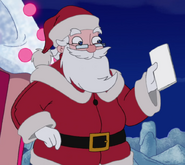| Santa Claus | |||
|---|---|---|---|
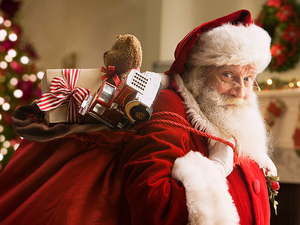
| |||
| Naming | |||
| Others | Nikolaos of Myra Saint Nicholas Saint Nick Father Christmas Kris Kringle Sinterklaas Neclaus (The Life and Adventures of Santa Claus) Lucas A. Nast (The Secret Santa) Santicus Clausimus (The Loud House) | ||
| Personal information | |||
| Species | Either Human or Elf (more commonly portrayed as the former) Mutant (Marvel Comics) | ||
| Gender | Male | ||
| Date of birth | December 25th 1 AD (first Christmas) 15 March 270 AD (Nikolaos of Myra) Early 14th century (Santa Claus: The Movie) | ||
| Affiliation | Elves and flying reindeer | ||
| Relations | Necile (adoptive mother; The Life and Adventures of Santa Claus) Mrs. Claus (wife; several sources) Kitty Claus (daughter; Santa Claus' Daughter) Jingle Belle (daughter; Jingle Belle) Fred Claus (brother; Fred Claus) | ||
| Occupation | Toy manufacturer | ||
| Current status | Active | ||
| Biology | |||
| Body type | Humanoid | ||
| Height | 5'6'' (Nikolaos of Myra) | ||
| Diet | Omnivorous | ||
| Abilities | Access to magic Immortality | ||
| Sentience | Sentient | ||
| Sapience | Sapient | ||
| Behind the scenes | |||
| Universe | Real | ||
| “ | Ho, ho, ho! |
” |
— Santa Claus' laughter.
| ||
Santa Claus - variably also known as Saint Nicholas, Father Christmas, Kris Kringle and a number of other aliases - is a mythical jolly old man who lives in the North Pole region and delivers gifts to well-behaved children annually on the night of Christmas Eve (December 24th). It's commonly believed that he spends the rest of the year monitoring children from distance, compiling the lists of those who are "naughty" and those who are "nice".
His house is surrounded by a community of cheerful small Elves who are employed on his workshop, manufacturing the gifts. In some portrayals the Elves may view Santa as their ruler as well as their boss. Santa himself, while most commonly portrayed as an immortal Human, has also been frequently described as a "jolly old elf", suggesting that he's either a natural or an honorable member of the race.
His trademark form of transportation is his magical flying sleigh, pulled by a team of flying reindeer - which may in some cases be portrayed as sapient. During his annual one-night trip he may also be accompanied by some Elves or other companions, a notable one being the monstrous Krampus - who may also be thought of as an "evil counterpart" to Santa, rather than an associate.
Etymologically, the name Santa Claus derives from "Sinterklaas", which in turn derives from Saint Nikolaos or Saint Nicholas, who lived in the 4th century AD.
Historical Portrayals
The modern Santa Claus figure originated circa the late 18th and early 19th century, deriving from a number of distinct sources, and is probably best regarded as an amalgam of facts, folklore and fiction. He is chiefly based on the historical 4th century Greek bishop known as Nikolaos of Myra, a.k.a. Saint Nicholas; combined with the anthropomorphic personification of Christmas known to the British as Father Christmas; as well as other mythological figures such as the Slavic Ded Moroz, a.k.a. Father Frost. The name Kris Kringle derives from the Germanic angel-like gift-bringer known as Christkindl ("Christ Child"), but has been popularized by the 1947 movie The Miracle of 34th Street as another common synonym for Santa Claus - although there is evidence that the name Krishkinkle was already used for Santa in some American regions in the 19th century.
In its earliest roots, it's possible that the general tradition of a figure who delivers gifts to the children during the holiday seasons may originate from the biblical Three Kings, or Magi, who brought gifts to the infant Jesus Christ on the Twelfth Night (January 5th or 6th, depending on the tradition).
It's also sometimes believed that the modern Santa Claus may have drawn elements from the Germanic god Wodan, a long-bearded, benevolent figure who crossed the night sky riding his horse while leading the "Wild Hunt" (a supernatural procession of celestial huntsmen), and also associated with the winter pagan holiday of Yule - which was mostly assimilated by Christmas after the spreading of Christianity throughout Europe. It's important to note that the identity of the Wild Hunt's participants and their leader varies enormously according to different traditions. They may be portrayed as elves, spirits, demons, the Fair Folk, or prominent figures from the past.
In any case, Santa as we know him is a relatively modern phenomenon. Prior to him there was chiefly Saint Nicholas, and the unrelated character Christmas, or Sir Christmas, which represented the personification of the holiday cheer and dates back to the reign of Henry VIII at least. Christmas as a character has appeared, for instance, in Ben Jonson's 1616 play Christmas, His Masque, as well as numerous other comedies from the Renaissance. This concept gave rise to the British tradition of a Father Christmas, today retroactively interpreted as synonymous with Santa Claus.
However, Father Christmas wasn't unanimously considered responsible for delivering gifts on Christmas Eve. While the tradition existed in 19th century England, the gift-bringing was sometimes performed by Fairies instead.
Also, it was common for Father Christmas to be portrayed wearing a green coat, rather than his now ubiquitous red coat. The Ghost of Christmas Present from Charles Dickens' A Christmas Carol is probably at least partially inspired by Father Christmas.
In France, Santa Claus' name is Père Noël, which literally means Father Christmas.
Saint Nicholas
Nikolaos of Myra, better known as St. Nicholas, and also as Nikolaos the Wonderworker due to his miracles (including several stories of him reviving the dead), was born in 270 AD in the Greek city of Patara and spent most of his life in Myra, located in Lycia - a province of the Roman Empire in modern-day Turkey. After returning from a pilgrimage to Egypt and Palestine, he became known as Bishop of Myra, and is one of the several bishops known to have attended the First Council of Nicaea.
Nikolaos was widely known for his generousness and particularly for a story in which he helped the three daughters of a poor man by secretly visiting their house at night, leaving a purse filled with gold coins for each of them. Without this gift, the young maids without a dowry would probably have to resort to prostitution, but thanks to Nikolaos' gift they were able to get married.
One famous version of this story claims that Nikolaos left the purses on three consecutive years, each time before one of the girls' coming of age. In the third year, their father spent the night outside the window hoping to discover the identity of their secret benefactor, but since Nikolaos saw him, he climbed their roof instead and threw the purse down the chimney, where it fell inside an empty stocking that the youngest daughter had left there to dry.
In many European countries, some of the same gift-giving traditions commonly associated with Christmas are also practiced on St. Nicholas' Day (December 5th or 6th depending on the country).
Sinterklaas
Eventually, the notion of a wintertime gift-bringing Saint Nicholas was turned into the character known as Sinterklaas. When Dutch settlers immigrated to the United States in the 18th century, they brought the figure with them, and the folklore evolved into the modern Santa Claus. From that point, the American-Dutch character spread back to Europe where it merged with the similar Father Christmas from the U.K. and other continental counterparts.
However, to this day in the Netherlands and Belgium, Santa Claus and Sinterklaas are still treated as separate characters, even though both represent Saint Nicholas and one originated directly from the other. While Santa Claus (known in Dutch as de Kerstman and in French as Père Noël) delivers gifts on Christmas Eve, the long-robed Bishop-like Sinterklaas delivers them on the eve of St. Nicholas Day (December 5th). Other countries around the world also share similar traditions, with St. Nicholas bringing gifts on December 5th and either a Father Christmas-like figure or a Christ-child figure doing so on December 24th.
The modern Sinterklaas also has his own mythology which parallels that of the American Santa. He rides a white horse which children sometimes leave carrots to, and is usually accompanied by a cheerful figure known as Zwarte Piet (or Black Peter) - who dates back to the early 19th century. Sometimes there is not a single Zwarte Piet, but numerous Zwarte Pieten who help Sinterklaas. Besides all that, Sinterklaas and Zwarte Piet also differ from Santa Claus in that they come from the south, rather than the north - residing in Spain for most of the year.
Meanwhile, other European traditions have bestowed St. Nicholas with a much darker associate in the form of either Père Fouettard, Knecht Ruprecht, or Krampus, all of whom act as "evil counterparts" tasked with punishing the bad children while the Saint rewards the good ones. Note, however, that the name Père Fouettard is also used as a French equivalent for Zwarte Piet, a vastly different figure who is (usually) not evil at all.
Ded Moroz and Others
Some cultures may have a distinct winter figure similar to Santa Claus. One example would be the Slavic character known as Ded Moroz, a.k.a. Father Frost. However, Ded Moroz is more of a personification of winter and frost, and although portrayed as delivering gifts to the good children, he traditionally visits them at New Year's Eve rather than Christmas Eve, and delivers the presents in person, accompanied by his granddaughter Snegurochka, a.k.a. Snow Maiden.
Santa Claus analogues or counterparts also exist in other cultures. The Iranian figure known as Amu Nowruz or Papa Nowruz is a kind elderly man who appears annually to mark the beginning of Nowruz, the Iranian New Year, and gives gifts to children, escorted by his jovial companion Hajji Firuz.
In Basque culture, the role of Christmas gift-bringer is fulfilled by the friendly big man known as Olentzero.
In many Scandinavian traditions, the Christmas gift-bringer takes the form of a tomte, who may also either ride a goat or shapeshift into one - hence the Finnish name Joulupukki, or Yule Goat for the local equivalent of Santa Claus. This and other related stories about tomtes delivering gifts may have influenced the modern concept of Santa being described as an elf and/or having elves for assistants. It's also possible that the goat aspect may be inspired by the Devil and represent Saint Nicholas' control over it, which in itself may have influenced the stories about Krampus. In Iceland, Santa's role is played by multiple Yule Lads, who usually number thirteen.
Modern Portrayals
The most common modern image of Santa Claus is that of an elderly Caucasian man with a long white beard, generally wearing a red coat and hat, and who sometimes wears spectacles. He lives with his wife, reindeer and the associated elf community somewhere near the North Pole, where his house and workshop are located. In some traditions, he may live in Lapland.
Every year on Christmas Eve, Santa packs his sleigh with an enormous bag of presents and flies all over the world to deliver the gifts (and the coal), sometimes accompanied by some of his elves. The sleigh is generally pulled by the eight (or nine) flying reindeer and his arrival is announced by the ringing of his sleigh bells. He's also easily recognized by his trademark "Ho, ho, ho!" laughter.
A secretive figure, Santa avoids showing up unless the children are sleeping. He usually enters the houses through the chimney (in houses that have one) or through the window, and furtively leaves gifts for the nice children and coal for the naughty ones. These are left either inside shoes or stockings (which are traditionally hung next to the fireplace for this purpose) or below the Christmas tree. In some places it is customary for children to leave milk and cookies for Santa, and sometimes carrots for the reindeer - the latter one may have developed from the tradition of leaving carrots to the horse of Saint Nicholas. Writing letters to Santa Claus in December is also a common tradition among Western children.
Today it's very common for shopping places and department stores to employ people dressed up as Santa Claus and his associates to greet children during the holiday seasons. Santa is also widely known as one of the mascots of Coca-Cola, appearing in their December advertisings since the 1930s.
Relatives and Associates
Today, Santa is typically depicted as married. His wife, Mrs. Claus, has no clear folkloric origins, but has been present in literature since at least 1849. Her first name is rarely mentioned, although Santa Claus: The Movie names her Anya. In the 2007 comedy Fred Claus she's named Annette.
The flying reindeer, sleigh and the Christmas elves also appear to be literary creations. The 1821 poem "Old Santeclaus with Much Delight", by an unknown author, depicted Santa on a sleigh pulled by a single reindeer. The traditional team of eight flying reindeer were probably created and first named in the 1823 poem "A Visit from St. Nicholas", attributed to Clement C. Moore. Here their names are given as Dasher, Dancer, Prancer, Vixen, Comet, Cupid, Donner and Blitzen. The ninth member on the team, Rudolph the Red-Nosed Reindeer, is a recent addition, created by Robert L. May in 1939. In Baum's The Life and Adventures of Santa Claus, the team actually consists of ten reindeer named Flossie, Glossie, Racer, Pacer, Fearless, Peerless, Ready, Steady, Feckless and Speckless. Additionally, Baum describes the reindeer as leaping overly long distances, rather than properly flying.
Santa's Elves, meanwhile, first appeared in literature in 1856, in Louisa May Alcott's book Christmas Elves. The description of Santa himself as an elf in Clement C. Moore's poem predates it, as do Scandinavian traditions associating St. Nicholas with tomtes or nisses (elf-like or gnome-like mythical beings).
In the 1892 play Santa Claus' Daughter, by Everett Elliott and F. W. Hardcastly, Santa is portrayed as the immortal king of the North Pole and has an 18-year-old daughter named Kitty Claus. Incidentally, the play presents the personification of Christmas as a separate minor character, being one of the Four Holidays along with the Fourth of July, Thanksgiving and New Year.
Magical Abilities
While it's commonly agreed that Santa has at least some access to magic, the extent of his abilities is rarely discussed. He flies in a magical sleigh pulled by his team of flying reindeer, and probably has access to some sort of powerful magic to allow him to deliver gifts to all the world's children, let alone in a single night. He also has means of monitoring all the children throughout the year, in order to assert which ones are "naughty" and which ones are "nice" - writing their names down on the respective lists.
Furthermore, he is most certainly an immortal, given that legends about him have existed for hundreds of years and he's commonly equated with the figure of Saint Nicholas, who lived in the late 3rd and early 4th centuries. Conversely, some works of fiction portray "Santa Claus" as an inheritable title, which's been held by numerous people over many generations. An example of this would be the movie Ernest Saves Christmas, the plot of which revolves around finding the next Santa Claus to replace the old one at the end of his tenure.
Modern Fiction
In L. Frank Baum's The Life and Adventures of Santa Claus, the man who would become known as Santa Claus was abandoned in the woods as an infant and raised by a wood nymph named Necile, thus being given the name Neclaus, which means "Necile's little one". After meeting other humans for the first time, he devoted his life to bringing joy to the children, and at the end of it, the Council of Immortals granted him with eternal life so that he could continue this mission.
In The Father Christmas Letters by J. R. R. Tolkien, Father Christmas is portrayed as a wise and benevolent figure, as old as Christmas itself (making him older than St. Nicholas), and is identified as the son of "Grandfather Yule" - acknowledging the pagan holiday that predates Christmas. He has the traditional Elves as helpers (not to mention the friendly, but hapless North Polar Bear), and small evil Goblins as his enemies, with the book describing some battles between the Elves led by Father Christmas and the ravenous bat-riding Goblins.
In The League of Extraordinary Gentlemen, Santa appears as a sort of solitary Arctic shaman and his travels around the world on Christmas Eve appear to be spiritual, rather than physical.
In the 2014 documentary The Secret Santa, he uses the anagram alias Lucas A. Nast.
Some cartoon universes such as Ice Age and The Flintstones paradoxically depict Santa Claus existing in prehistoric times, long before the existence of Christmas.
In the science fiction comedy cartoon series Buzz Lightyear of Star Command, Santa Claus resides in a space outpost named North Polaris and has the alien Little Green Men for assistants rather than Elves. His ability to deliver gifts to the whole galaxy in a single night is made possible not by magic, but by extraordinarily advanced technology.
The Santa Claus figure also exists in some way in the culture of the microscopic Whos from Whoville in Dr. Seuss' How the Grinch Stole Christmas. Although Santa himself doesn't appear in the book, the Grinch famously impersonates him.
In the Grimm episode "Let Your Hair Down", it's implied that Santa Claus is a type of Wesen known as a "Gefrierengeber".
Appearances in Popular Culture
Literature
- The Life and Adventures of Santa Claus, by L. Frank Baum
- The Father Christmas Letters, by J. R. R. Tolkien
Film
- Ernest Saves Christmas
- Fred Claus
- The Great Santa Claus Switch
- Mickey's Twice Upon a Christmas
- The Nightmare Before Christmas
- One Magic Christmas
- Rise of the Guardians
- Santa Claus: The Movie
- Santa Claus Conquers the Martians
- The Santa Incident
- Santa Who?
- The Secret Santa
Television
- Ace Ventura: Pet Detective
- American Dragon: Jake Long
- American Dad!
- The Adventures of Sonic the Hedgehog
- Brandy and Mr. Whiskers
- Bonkers
- Buzz Lightyear of Star Command
- Darkwing Duck
- The Fintstones
- Family Guy
- Inspector Gadget
- Johnny Bravo
- Kenan and Kel
- The Mask: Animated Series
- Men in Black: The Series
- Mickey Mouse Clubhouse
- Pinky and the Brain
- Phineas and Ferb
- Pokémon
- The Super Mario Bros. Super Show
- The Twilight Zone
- TaleSpin
Video Games
- Papa Louie series
- Super Mario 64 (Mentioned only)
Gallery
Notes
- On December 23rd 2008, Santa Claus was officially given Canadian citizenship status by the government of Canada.

